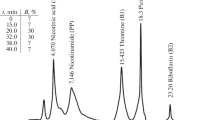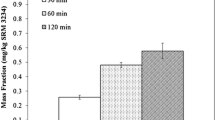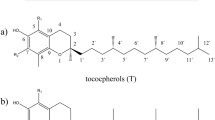Summary
A standardized method to determine the vitamin D content of food by means of HPLC is described. After the test material was homogenized and saponified with ethanolic aqueous potassium hydroxide solution, vitamin D was extracted usingn-hexane. Using HPLC on a silica gel column, the fraction containing vitamin D is separated from the nonsaponifiable residue. After the fraction was reduced, the residue was dissolved in methanol and the vitamin D content determined after HPLC separation on an RP-C18 column. For evaluation, either a conventional external standard method using laboratory and matrix specific recovery rates as correction factors, or an internal standard method using vitamin D2, and D3, respectively as internal standards were employed. The method was developed and standardized by the working group “Vitamin Analysis” in accordance with § 35 LMBG (German Food Act). Repeatability and comparability of the results were checked in collaborative studies (14 laboratories) in milk powder and gruel that had been enriched with vitamin D3. Applicability of the method to other food (eggs, milk, fish, margarine) was checked separately. The statistical evalution of the results of the collaborative studies has shown that the method is reliable enough to be included into the “Amtliche Sammlung” (official collection of analytical methods) according to § 35 LMBG. The present method may be used to determine the content of vitamin D2 and D3 in natural and vitaminized food. It is specific for the vitamins D2 and D3 released during saponification of food, but does not allow separate determination of the pre-vitamins D already present in the sample.
Zusammenfassung
Eine standardisierte Methode zur quantitativen Bestimmung von Vitamin D in Lebensmitteln mittels HPLC wird beschrieben. Nach dem Homogenisieren und Verseifen des Untersuchungsmaterials mit ethanolisch-wäßriger Kaliumhydroxid-Lösung wird Vitamin D mitn-Hexan extrahiert. Aus dem unverseifbaren Rückstand wird unter Anwendung der Hochleistungsflüssigchromatographie (HPLC) auf einer Silikagel-Säule (NP) eine das Vitamin D enthaltende Fraktion abgetrennt. Nach Einengen der Fraktion wird der Rückstand in Methanol gelöst und der Gehalt an Vitamin D nach HPLC-Trennung auf einer RP-C18-Säule mittels UV-Detektor bestimmt. Die Auswertung erfolgt konventionsgemäß nach der externen Standardmethode unter Verwendung laborinternen und matrixspezifischen Wiederfindungsraten als Korrekturfaktoren oder nach der internen Standardmethode unter Verwendung von Vitamin D2 bzw. D3 als internem Standard. Das Analysenverfahren wurde im Rahmen des § 35 LMBG von der Arbeitsgruppe „Vitaminanalytik“ ausgearbeitet, standardisiert und die Wiederholbarkeit sowie Vergleichbarkeit der Analysenergebnisse in Ringversuchen (14 Teilnehmer) an mit Vitamin D3 angereichertem Milchpulver und Haferschleim überprüft. Die Anwendbarkeit der Methode für die Untersuchung von anderen Lebensmitteln (Eier, Milch, Fisch und Margarine) wurde außerhalb des Ringversuches in einem Labor untersucht. Die statistische Auswertung der Ergebnisse der Ringversuche ergab einen genügend hohen Grad an Zuverlässigkeit, um die Methode für die Aufnahme in die „Amtliche Sammlung“ nach § 35 LMBG zu empfehlen. Das vorliegende Analysenverfahren ist für die quantitative Bestimmung von Vitamin D2 und D3 in natürlichen und vitaminierten Lebensmitteln anwendbar. Es erfaßt die bei der Verseifung von Lebensmitteln freigesetzten Vitamine D2 und D3. Eine separate Bestimmung der in der Analysenprobe bereits enthaltenen Prävitamine D ist mit der Methode nicht möglich.
Similar content being viewed by others
Literatur
Chemische Bestimmung von Vitamin D in diätetischen Lebensmitteln. L-49.00-1, 1982. Amtliche Sammlung von Untersuchungsverfahren nach § 35 LMBG. Beuth Verlag, Berlin
Bestimmung von Vitamin D in diätetischen Lebensmitteln. L-49.00-1, 1991. Amtliche Sammlung von Untersuchungsverfahren nach § 35 LMBG. Beuth Verlag, Berlin
Bestimmung von Vitamin A in diätetischen Lebensmitteln. L-49.00-3, 1985. Amtliche Sammlung von Untersuchungsverfahren nach § 35 LMBG. Beuth Verlag, Berlin
Amtliche Sammlung von Untersuchungsverfahren nach § 35 LMBG. 1991, Beuth Verlag, Berlin
Nabholz A, Herfort S (1980) High pressure liquid chromatography; determination of vitamin D in dietetic products. Trav Chim Aliment Hyg 71:100–107
De Vries EJ, Borsje B (1982) Analysis of fat-soluble vitamins. XXVIII. High performance liquid chromatography and gas-liquid Chromatographic determination of vitamin D. In: Fortified milk and milkpowder: collaborative study. J Assoc Off Anal Chem 65:1228–1234
Vitamin D in fortified milk and milkpowder. Liquid Chromatographic method (1984). In: Official Methods of Analysis (AOAC), 14th edn. Arlington, pp 43.110–43.117
Kobyashi T, Okano T, Takenchi A (1986) The determination of vitamin D in foods and feeds using high-performance liquid chromatography. J Micronutr Analy 2:1–24
Rychener M, Walter P (1985) Vereinfachte und verbesserte Bestimmung von Vitamin D in Fett, Öl und Margarine mit HPLC. Mitt Geb Lebensm Hyg 76:112–124
Isler O, Brubacher G (1982) Gleichgewichtszustand von Prävitamin D und Vitamin D in Abhängigkeit von der Temperatur und der Zeit. Vitamine I (Fettlösliche Vitamine). Thieme Verlag, Stuttgart, S 98
Bognár A (1986) Bestimmung von Vitamin A in Lebensmitteln mittels Hochleistungs-Flüssigchromatographie (HPLC). Ergebnisse von Ringversuchen der Arbeitsgruppe „Vitamin-Analytik“ nach § 35 LMBG. Z Lebensm Unters Forsch 182:492–497
Souci, Fachmann, Kraut (1990) Nährwert-Tabellen 1989/90. Wissenschaftlicher Verlag, Stuttgart
Author information
Authors and Affiliations
Additional information
Mitglieder der Arbeitsgruppe: Frank Böhme, Harald Brückner, Michael Bernstein, Ursula Coors, Rosemarie Gerstl, Christian Gertz, Rolf Godelmann, Kai Habersaat, Hans Henning (verstorben), Edgar Ohst, Markus Piloty, Robert Siegfried, Enrico Tagliaferri, Günther Raffler, Wolfgang Sanitz, Siegfried Vierkötter
Rights and permissions
About this article
Cite this article
Bognár, A. Bestimmung von Vitamin D in Lebensmitteln mittels Hochleistungsflüssigchromatographie (HPLC). Z Lebensm Unters Forch 194, 469–475 (1992). https://doi.org/10.1007/BF01197731
Received:
Issue Date:
DOI: https://doi.org/10.1007/BF01197731




